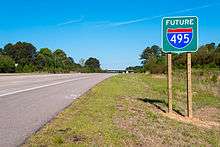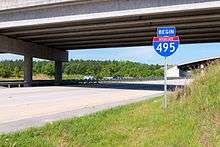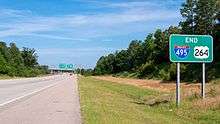Interstate 87 (North Carolina)
Interstate 87 (I-87) is a partially completed Interstate Highway in the U.S. state of North Carolina, currently the shortest designated primary Interstate Highway at 12.9 miles (20.8 km). The completed portion is in eastern Wake County, between Raleigh and Wendell; the majority of the completed route (approximately 10 miles (16 km)) is known as the Knightdale Bypass, while the remaining 3 miles (4.8 km) follows the Raleigh Beltline (Interstate 440). It is planned to continue northeast through Rocky Mount, Williamston and Elizabeth City, ending in Norfolk, Virginia.[1] It is signed as north-south, in keeping with the sign convention for most odd-numbered interstates, but the route goes primarily east-west, with the eastern direction aligning to the north designation. The entire route is concurrent with US 64, with portions also concurrent with I-440 and US 264.
| ||||
|---|---|---|---|---|
%26groups%3D_45329f8980f76dd6a7c21495fc6237994fa2c73a.svg)
I-87 highlighted in red | ||||
| Route information | ||||
| Maintained by NCDOT | ||||
| Length | 12.9 mi (20.8 km) | |||
| Existed | 2017–present | |||
| Major junctions | ||||
| South end | ||||
| ||||
| North end | ||||
| Location | ||||
| Counties | Wake | |||
| Highway system | ||||
| ||||
Route description
I-87 is a six-lane interstate highway that connects I-40, in Raleigh, to Rolesville Road, in Wendell; it is entirely concurrent with US 64. The speed limit for majority of the route is 70 miles per hour (110 km/h).
The southern terminus is at the interchange of I-40 and I-440 (Raleigh Beltline) in Southeast Raleigh, at I-40 exit 301/I-440 exit 16. I-87 north follows I-440 west for approximately 3 miles (4.8 km) before exiting the Beltline at exit 14 to follow the US 64/US 264 (former I-495) freeway, known locally as the Knightdale Bypass. Following the Bypass south of Knightdale, I-87 has interchanges with two local roads (New Hope Road and Hodge Road) before meeting the current eastern terminus of I-540. Two more local roads follow (Smithfield Road and Wendell Falls Parkway) before the I-87 designation ends at a complex interchange with US 64 Bus./Knightdale Boulevard/Wendell Boulevard and Rolesville Road.
A portion of this freeway (from I-440 to I-540) was formerly designated I-495 from 2013 to 2017. I-495 signs were removed, and mileage markers and exit numbers were changed to reflect the redesignation in May 2019.[2][3]
Beyond Rolesville Road, the US 64 freeway from Wendell to Williamston is designated as Future I-87. It does not currently meet interstate highway standards and will need wider travel lanes, wider shoulders and crossover-prevention barriers added in the grass median. The remainder to the Virginia border is not built as a limited access freeway and require upgrading or building new roads parallel to existing US highways, including US 13, US 17 and US 158.
History
Interstate 495
| |
|---|---|
| Location | Raleigh–Knightdale, NC |
| Length | 4.09 mi[4][5] (6.58 km) |
| Existed | 2013–2017 |
A portion of I-87, originally named I-495, was first designated as an Interstate Highway on February 20, 2013, when the North Carolina Department of Transportation (NCDOT) submitted a request to AASHTO in order to establish Interstate 495 as a new auxiliary route of I-95. The proposed 44.99-mile (72.40 km) route would begin at I-440/US 64/US 64 Business in Raleigh and would end at I-95, in Rocky Mount, completely concurrent with US 64.[6]
On March 15, 2013, AASHTO received a modified request from NCDOT requesting the establishment of I-495 from I-440 to I-540 (4.09 mi or 6.58 km) and Future I-495 from I-540 to I-95 (40.90 mi or 65.82 km). It was approved, though needed an additional approval from FHWA.[5] On December 12, 2013, the proposed section was approved by the FHWA and was added to the interstate highway system.[7]
The freeway section, the part that was originally to be signed I-495 and continuing east to US 64 Business, was completed in 2006. From I-440 to Rolesville Road, the freeway was built to interstate standards; which is why the first official section of I-495 was able to connect between I-440 and I-540.[8] East of Rolesville Road, the freeway was built in sections, since 1975. This older section of freeway will eventually be upgraded to interstate standards; which include road rehabilitation and wider lanes and shoulders.
Renumbering


Long-term plans by the Raleigh-Durham area's Regional Transportation Alliance (RTA) called for extension of the interstate east of I-95 toward Elizabeth City, then northeastward to the Interstate 64/Interstate 464 interchange in the Norfolk–Virginia Beach (Hampton Roads) metropolitan area. The NCDOT proposed the Interstate 44 designation for the Raleigh–Norfolk High Priority Corridor consisting of portions of the I-495 and US 64 in North Carolina and US 17 in North Carolina and Virginia. The route would connect two of the largest US metro areas lacking an Interstate connection: the Research Triangle area around Raleigh and the Hampton Roads metro area around Norfolk.[9][10]
NCDOT requested the addition of the corridor to the Interstate Highway System as I-44 in November 2012.[11] Congressman G. K. Butterfield introduced legislation in June 2014 to add the corridor to the Interstate Highway System through Congressional authority.[12] An NCDOT policy paper said they were "seeking language in the reauthorization of surface transportation programs legislation to enhance the description of the Raleigh–Norfolk Corridor to include the route via Rocky Mount–Elizabeth City for clarity, and to designate the entire route from Raleigh to Norfolk as a future part of the Interstate system as I-44 or I-50."[9][10] Had the I-44 designation been approved, it would have been discontinuous with the current I-44, which runs between Wichita Falls, Texas, and St. Louis, Missouri.
The proposed corridor was officially designated as a future interstate with the passage of the Fixing America's Surface Transportation Act (FAST Act) on December 14, 2015.[13] Soon, several other route numbers were discussed and the RTA set their preference on two more-likely candidates: Interstate 56 if an east-west designation were chosen, or Interstate 89 if a north-south designation were chosen.[14] I-56 is not in use, while I-89 exists in Vermont and New Hampshire, far north of this corridor.[14] For the upcoming AASHTO Special Committee on U.S. Route Numbering, NCDOT proposed I-89 for this route.[15] On May 25, 2016, AASHTO instead approved I-87 as the number for the highway.[15][16] The new I-87 would be non-contiguous with the route with the same number in New York State.[17] The Interstate 87 designation pays tribute to several important dates in the history of both North Carolina and Virginia. The Roanoke Colony was founded in 1587; James Madison's Virginia Plan helped to develop U.S. Constitution in 1787; and North Carolina State University was created in 1887.[18]
On May 23, 2017, AASHTO approved the request by NCDOT to decommission existing I-495 and Future I-495; they were replaced by I-87 and Future I-87.[19] I-87 signage were installed on September 5, 2017; in May 2019 mile markers and exit numbers were changed along the already completed segment from the I-440 junction to Rolesville Road. Exit numbers and mileage along the portion coincident with I-440 will retain I-440 mileage and exit numbers.[1][3] I-87 will continue east along US 64 to I-95 after the road is upgraded to interstate standards.[5][7]
Future
I-87 will extend from its current terminus at Rolesville Road to an undetermined location in Norfolk, Virginia. Current plans have the interstate running east along US 64 to Williamston. This section of US 64 is built as a freeway, but will need to be upgraded to Interstate highway standards. In Williamston, the interstate is planned to leave US 64 and begin following an alignment along present-day US 17.
A feasibility study for the section between Williamston and the Virginia state line was completed in 2018. NCDOT maps show the interstate roughly following the US 17 corridor between Williamston and South Mills, North Carolina. There are several areas, where the Interstate may deviate from the current routing of US 17, and be placed on a new freeway. To the north of South Mill, NCDOT has laid out two plans on how the Interstate would proceed to Virginia. One plan shows I-87 running north along US 17 to the Virginia state line. In contrast, a second plan shows an interchange with I-87 and US 17 just north of modern-day McPherson Road and the Dismal Swamp Welcome Center. I-87 would then proceed to the east along new routing to NC 168/Virginia State Route 168 (SR 168). The interchange with Route 168 would take place just north of the North Carolina-Virginia state line. If NCDOT was to choose this alignment as the preferred route, I-87 would presumably follow SR 168 to Norfolk. NCDOT estimates that the section between Williamston and the Virginia state line could cost between $849.7 million and $945.2 million.[20]
Some of these upgrades are part of the DOT 10-year plan released in 2017, with upgrading of highways around Elizabeth City given a start date of 2023.[21]
As of July 24, 2019, Virginia does not have a timetable to complete their section of Interstate 87. US 17 is a four-lane expressway between the North Carolina state line and Norfolk. State Route 168 is a four-lane expressway for approximately 1.8 miles[22] between the state line and Battlefield Boulevard. North of Battlefield Boulevard, SR 168 is a four lane toll limited access freeway known as the Chesapeake Expressway.
Exit list
Current exit numbers were signed in May 2019. The entire route is in Wake County.
| Location | mi | km | Old exit | New exit | Destinations | Notes | |
|---|---|---|---|---|---|---|---|
| Raleigh | 0.0 | 0.0 | — | Continuation as I-40 / US 64 | |||
| 16 | Western end of I-440 concurrency. Mile markers and exit number based on I-440 mileage | ||||||
| 15 | Poole Road | Mile markers and exit number based on I-440 mileage | |||||
| 419 | 3 | Eastern end of I-440 concurrency; western end of US 264 concurrency; west/north direction signed as exit 14 | |||||
| 420 | 4 | New Hope Road | |||||
| Knightdale | 422 | 6 | Hodge Road | ||||
| 423 | 7 | ||||||
| | 425 | 9 | Smithfield Road | ||||
| Wendell | 427 | 11 | Wendell Falls Parkway | ||||
| 429 | 13 | For southbound entrance onto U.S. Route 64 Business East and northbound entrance from U.S. Route 64 Business West, use Rolesville Road. | |||||
| 430 | 14 | Rolesville Road – Rolesville | Southbound exit and northbound entrance | ||||
| — | Continuation as US 64 / US 264 | ||||||
1.000 mi = 1.609 km; 1.000 km = 0.621 mi
| |||||||
Auxiliary routes
I-87 in North Carolina will eventually have one spur route, I-587, that overlays US 264 to Greenville, North Carolina.
See also

References
- Stradling, Richard (September 6, 2017). "Have you driven on I-87 yet?". The News & Observer. Raleigh, NC. Retrieved September 6, 2017.
- Stradling, Richard. "Have you driven on Interstate 87 yet?". The News & Observer. Raleigh, NC. Retrieved September 19, 2017.
- "Changes in Exit Numbers for I-87 Start Next Week" (Press release). Raleigh, NC: NCDOT. May 10, 2019. Retrieved May 10, 2019.
- Google (December 14, 2013). "Interstate 495" (Map). Google Maps. Google. Retrieved December 14, 2013.
- Lacy, J. Kevin (March 27, 2013). "An Application from the State Highway or Transportation Department of North Carolina" (PDF). Letter to Frederick G. Wright. Raleigh: North Carolina Department of Transportation. Archived from the original (PDF) on October 19, 2013. Retrieved December 14, 2013 – via American Association of State Highway and Transportation Officials.
- North Carolina Department of Transportation (December 14, 2013). I-495 Route Change (2013-02-20) (PDF) (Map). c. 1:422,400. North Carolina Department of Transportation. Retrieved February 28, 2013.
- North Carolina Department of Transportation (December 14, 2013). "North Carolina Gets a New Interstate, with the I-495 Designation near Raleigh" (Press release). North Carolina Department of Transportation. Archived from the original on July 5, 2017. Retrieved December 12, 2013.
- North Carolina Department of Transportation (November 8, 2006). "US 64 Route Change (2006-11-08)" (PDF). North Carolina Department of Transportation. Retrieved December 14, 2013.
- North Carolina Department of Transportation (June 11, 2014). "Future Interstate Designation: Raleigh, NC to Norfolk, VA" (PDF). North Carolina Department of Transportation. Archived from the original (PDF) on May 23, 2015. Retrieved September 4, 2014 – via Regional Transportation Alliance.
- "Interstate 495 to Rocky Mount—Future I-44 to Hampton Roads". Raleigh, NC: Regional Transportation Alliance. December 14, 2013. Retrieved February 16, 2014.
- Gibson, Terry R. (November 27, 2012). "Archived copy" (PDF). Letter to John F. Sullivan III. Raleigh: North Carolina Department of Transportation. Archived from the original (PDF) on May 17, 2014. Retrieved May 15, 2014.CS1 maint: archived copy as title (link)
- Tata, Anthony J. (June 11, 2014). "Route to Opportunity and Development Act (ROAD Act)" (PDF). Letter to G.K. Butterfield. North Carolina Department of Transportation. Archived from the original (PDF) on May 23, 2015. Retrieved September 4, 2014.
- "H. R. 22—111" (PDF). Retrieved March 31, 2016.
- Milazzo, Joe, II (December 31, 2015). "Raleigh-Norfolk: I-495, I-44, I-50, I-89, I-56 ... ?". Raleigh, NC: Regional Transportation Alliance. Retrieved February 1, 2016.
- Special Committee on U.S. Route Numbering (May 24, 2016). "Special Committee on U.S. Route Numbering" (PDF) (Report). Washington, DC: American Association of State Highway and Transportation Officials. Archived (PDF) from the original on December 16, 2017. Retrieved May 26, 2016.
- Siceloff, Bruce (May 25, 2016). "Future Interstate Highway Names Approved". The News & Observer. Raleigh, NC. Retrieved May 25, 2016.
- Walker, Sam (May 26, 2016). "Future interstate from Chesapeake to Raleigh will be I-87". The Outer Banks Voice. Retrieved August 14, 2017.
- "North Carolina Gets Designations for 2 More Interstates". Raleigh, NC: WRAL-TV. May 26, 2016. Retrieved December 2, 2016.
- Special Committee on U.S. Route Numbering (May 23, 2017). "Special Committee on U.S. Route Numbering" (PDF) (Report). Washington, DC: American Association of State Highway and Transportation Officials. p. 5. Archived (PDF) from the original on January 13, 2019. Retrieved June 9, 2017.
- "U.S. 17 Feasibility Study". North Carolina Department of Transportation. N.C. Department of Transportation. Retrieved July 24, 2019.
- Hawley, Jon. "I-87 work part of DOT's 10-year plan". Elizabeth City Daily Advance. Retrieved September 19, 2017.
- Google (July 24, 2019). "Interstate 87 (North Carolina)" (Map). Google Maps. Google. Retrieved July 24, 2019.
External links
| Wikimedia Commons has media related to |

